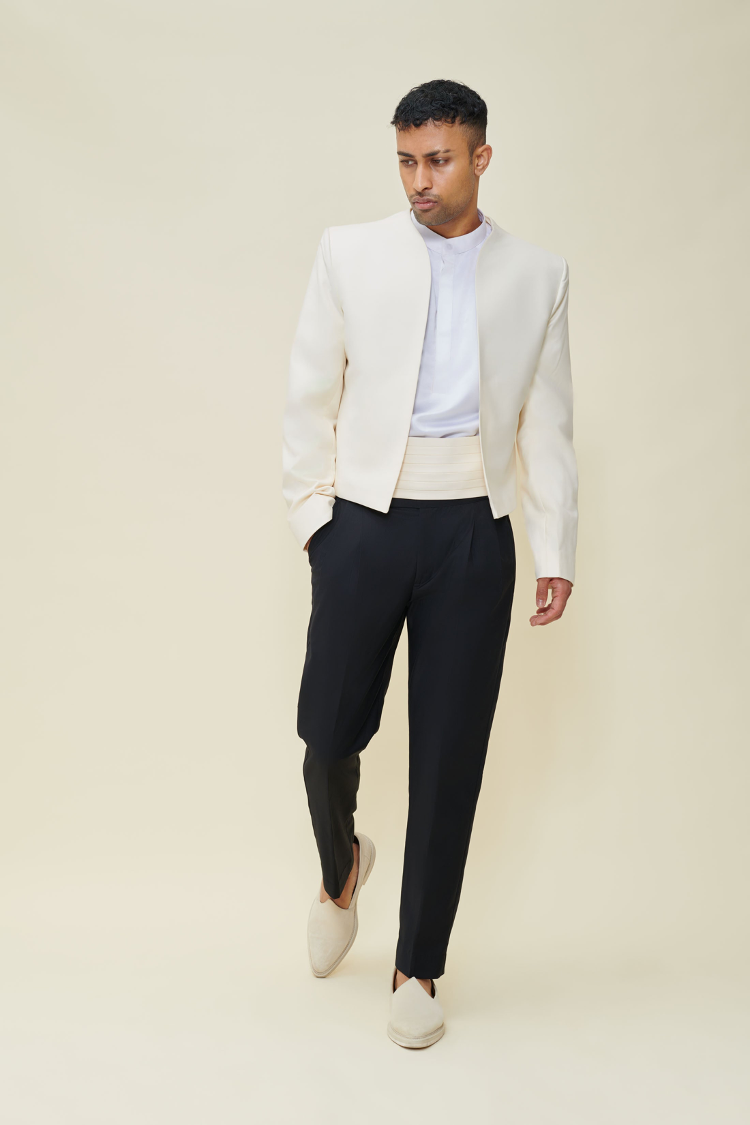Sacred Pleats Between Cultures
At the intersection of heritage/silhouette, SAAF stands tall, clean, pleated, and unwavering.
Words by Brittni Morrison
There’s a certain kind of silence that only tailoring can hold. A stillness in the pleat, a story in the seam. With SAAF GARMENTS’ Season One, designer Osama Syed doesn’t just launch a collection — he opens a portal. One that folds South Asian tradition into the minimalist rigor of New York, leaving behind a trail of garments that feel more like declarations than clothes. "Saaf," meaning clean in Urdu, is more than just etymology — it’s a worldview.
This is minimalism made intimate. Quietly radical. Purposefully symbolic. Every decision — a standing collar, a pleated panel, a perfectly controlled color story — is made with a level of spiritual poise. There’s nothing decorative here. Everything is considered. And in that consideration, SAAF claims space.
Season One – Campaign I, titled “The Introduction,” sets the tone for something much larger than a single collection. It reads like a prologue. A sacred script of what it means to navigate two worlds with honor and clarity. We’re introduced to a monochromatic world — black and ivory, darkness and light — and within it, the balance between those forces is not just aesthetic; it’s philosophical. This isn’t fashion as trend. It’s fashion as positioning. What we see: Pleated kurtas that carry the grace of ceremonial attire while moving with urbanity. Structured coats that assert presence, echoing the architectural memory of South Asia’s long lines and sacred thresholds. A series of cummerbunds — historically overlooked but newly elevated — acting as both accessory and armor. The silhouettes don’t scream. They stand. They suggest a genderless fluidity without ever flattening identity. These are uniforms for the in-between; Clothes for the modern diaspora — those who embody both tradition and transition.
Shot against soft neutral backdrops, the clothing is allowed to breathe — and it does. The images don’t rely on spectacle. They offer something rarer: presence. There’s weight in the way the garments fall. Precision in the fit. The wearers appear less like models and more like guardians — protectors of a lineage too often misrepresented or ignored. This is not fusion fashion. There is no attempt to “modernize” for the sake of trend. Instead, Syed builds a new visual lexicon — one that respects what came before without apology, while stepping forward with radical refinement. What we’re witnessing is a kind of quiet luxury that isn’t about wealth — it’s about knowing. Knowing where you come from. Knowing how to honor it. Knowing that the right garment can turn a hallway into a procession. They are tailoring as cultural offering.
SAAF is produced between India, Italy, and New York — an intentional triangulation of cultural gravities and a love letter to diaspora precision. But its power lies in how it avoids the cliches of multiculturalism. There’s no romanticization here. Only craft. Designer Osama Syed makes it clear: this is for the in-betweeners — those who grew up with aunties in silk saris and concrete stoops, whose holidays oscillated between Eid and Thanksgiving, who had to learn how to translate tradition into casual defiance. Every piece in SAAF Season One speaks to that tension. The need to be polished, but not performative. Rooted, but not restricted. The garments are, in a sense, spiritual translations — what it means to inherit, evolve, and embody at the same time. SAAF GARMENTS arrives not as a trend, but as textile testimony. A love letter to memory, to masculinity unbound, to ceremony redefined. These garments are uniforms for the new kind of elder — one who walks through the world without the need to explain, draped not in nostalgia but in intention.Syed has done what few designers dare: He’s taken the sharpest tools of tailoring and carved out a space for reverence. For heritage. For poise. This is not just a collection. It is a call to alignment — and an invitation to walk, cleanly and powerfully, toward your own center.
MEDIA CONTACT: L.E.R. Public Relations




































